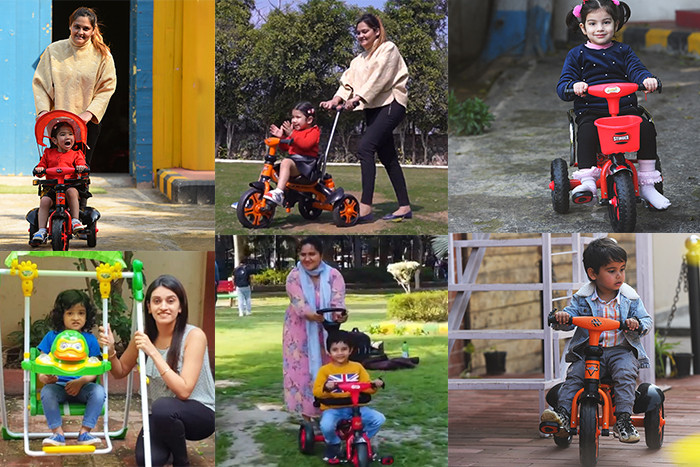How to teach my baby to ride a tricycle?
Apr 09, 2024

Teaching a baby to ride a tricycle is an exciting milestone in their development. Not only does it provide a fun and enjoyable activity, but it also offers a range of benefits for their physical and cognitive growth. Learning to ride a tricycle at a young age helps improve balance, coordination, and motor skills. It also promotes independence and confidence as the baby learns to navigate their surroundings on their own. In this blog, we will explore the step-by-step process of teaching a baby to ride a tricycle, along with tips and safety precautions to ensure a positive and rewarding experience for both the baby and the parent.
Preparation before Teaching:
Before starting the tricycle riding lessons, it's essential to ensure that the tricycle is the right size and height for the baby. A tricycle that is too big or too small can be uncomfortable and challenging to ride. Choose a tricycle that allows the baby to comfortably reach the pedals and handlebars.
Additionally, selecting a safe and suitable location for teaching is crucial. A flat, open area with no traffic is ideal for teaching a baby to ride a tricycle. This type of environment provides a safe space for the baby to practice riding without the risk of accidents or distractions.
Step-by-Step Guide to Teach Your Kid Tricycle:
Teaching a baby to ride a tricycle involves several simple steps that gradually build their confidence and skills:
Step 1: Climbing on and off the tricycle
Hold the tricycle to prevent it from sliding.
Encourage the baby to climb on and off the tricycle safely.
Step 2: Scooting forward on the tricycle
Teach the baby to scoot forward using their feet.
Practice balancing and steering while scooting.
Step 3: Steering the tricycle
Guide the baby in steering the tricycle using the handlebars.
Practice turning and maneuvering around obstacles.
Step 4: Riding with support to pedal and steer
Assist the baby in pedaling the tricycle.
Provide support as needed while the baby learns to pedal and steer simultaneously.
Each step helps the baby develop the skills and confidence needed to ride a tricycle independently.
Tips and Tricks for Parents
Use encouraging words and gestures to motivate the baby. Positive reinforcement can go a long way in building the baby's confidence and encouraging them to continue trying. Offer praise and encouragement when they make progress, no matter how small.
Be patient and allow the baby to progress at their own pace. Every baby learns at their own speed, so it's important to be patient and not rush the process. Allow them to practice and become comfortable with each step before moving on to the next.
Provide positive reinforcement and praise for their efforts. Celebrate the baby's achievements, no matter how small, to keep them motivated and excited about learning to ride a tricycle. This positive reinforcement will help them stay engaged and eager to continue learning.
Safety Precautions for Parents While Teaching Tricycle
Always supervise the baby while they are riding the tricycle. Supervision is crucial to ensure the baby's safety and prevent accidents. Stay close by to assist them if needed and to intervene in case of any potential dangers.
Ensure the baby wears a helmet and other protective gear. Safety should always come first. Make sure the baby wears a properly fitted helmet to protect their head in case of falls or collisions. Additionally, consider other protective gear such as knee and elbow pads to prevent injuries.
Teach the baby basic road safety rules, such as looking both ways before crossing. Instilling good safety habits early on is essential. Teach the baby to be aware of their surroundings and to always look both ways before crossing a street or entering a new area. This will help them stay safe while riding their tricycle.
Conclusion
Teaching your baby to ride a tricycle is a memorable experience that comes with numerous benefits. It not only promotes physical activity but also enhances their balance, coordination, and confidence. By following the step-by-step guide and safety precautions outlined in this blog, you can ensure a safe and enjoyable learning experience for your baby.
Remember to be patient and allow your baby to progress at their own pace. Celebrate their achievements, no matter how small, and provide positive reinforcement to keep them motivated. Most importantly, enjoy the learning process with your baby and create lasting memories together.

